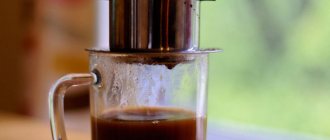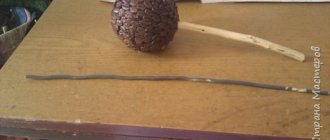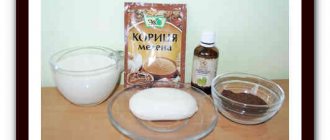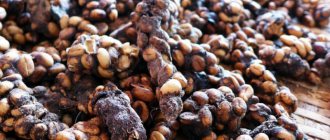This method of preparation is definitely not for coffee snobs or purists, but it will become a sweet spot on the coffee map of the world for lovers of an invigorating drink. Our article about Vietnamese coffee. Vietnam is not a rich country, so Robusta is more often consumed here than Arabica, and to diversify its taste, coconut or palm oil is added when roasting the grain. The grains turn out to be large, oily with a confectionery aroma that bears little resemblance to those we are used to. They don’t produce milk in Vietnam, so residents began adding our Soviet condensed milk to the drink, which they were accustomed to because of the humanitarian aid of the Soviet Union, back in the 50s.
So, Vietnamese coffee is sweet, invigorating (because Robusta has more caffeine), and perfectly cooling in the heat if you add a few ice cubes to the glass of the drink. Try it yourself!
Drink recipe with condensed milk
You will get a more refined coffee if you brew it with the addition of condensed milk. The highlight of this recipe is that the drink is carefully poured into the condensed milk without mixing the ingredients.
Ingredients:
- Two teaspoons of ground grains;
- A few tablespoons of condensed milk;
- One hundred milliliters of boiling water.
Cooking method:
- Pour condensed milk into a cup, place a press filter on top and wait for the drink to brew.
- When it's ready, remove the filter.
- If you brew it in a transparent glass container, you will see a clear line between the white milk and the black drink.
- Now you can mix everything and enjoy delicious sweet Vietnamese coffee.
- You can vary this recipe by adding ice cubes at the end.
Enjoy your coffee!
Vietnamese coffee - general overview
Today, Vietnam supplies the market of almost all countries with robusta for blended varieties and the production of instant coffee. The country's humid and warm climate makes it possible to grow a coffee tree at the lowest cost, since robusta is unpretentious in care. Robusta has a sharp aroma and a strong bitter taste.
Arabica is grown in very limited quantities in the country. It was first brought here by French missionaries. In the Tonkino region, over eleven years from 1865 to 1876, more than four hundred thousand coffee trees brought from the island of Java were planted. Vietnamese Arabica with a soft and delicate taste is most popular in Japan, Belgium, Germany and the USA.
Other species grown in Vietnam include Chari, Katimor. Chari is sometimes called Excelsa. But their share is insignificant - less than one percent.
After the end of the war with the United States in 1970, the country's government set out to make the coffee industry a leading one in the economy. Extensive robusta plantations were established in the central regions of the country. Robusta produced consistently high yields and its quality improved. And when the Vietnamese market was opened to foreign partners, the Vietnamese coffee industry experienced a real boom.
In the 1990s, the country became the world's second largest coffee producer. It is characterized by the fact that the cultivation and processing of coffee beans occurs mainly on small farms, although the state also owns large plantations.
Vietnam has rapidly gone from a modest supplier to a giant manufacturer . Considering Vietnam's success in producing robusta, it can be assumed that over time, Arabica and gourmet coffee varieties from this country will enter the world market. During the first half of the current year 2012, for the first time in the history of Vietnam, the republic overtook the leader of the world coffee business, Brazil, by 13% in terms of export volumes.
Where to buy Vietnamese coffee
When you return home, you will want to enjoy your favorite taste of Vietnamese coffee in the morning, so buy several kilograms during your trip. 100 g of Vietnamese coffee is enough for a week, provided that two people drink a cup of hot drink every morning. Good varieties in Vietnam cost only $5-10 per 500 g. If you are vacationing in Nha Trang or neighboring cities, it is best to buy coffee where it is grown: in Dalat or Dak Lak province. Prices there are lower than in tourist areas, and the chance of buying a fake is extremely low. It is best to buy the product in specialized stores (for example, La Viet Coffee in Dalat) and in local markets - tourist shops sometimes sell cheap varieties of coffee under the guise of expensive ones or add wood shavings to the ground beans. Excursion programs around Dalat and Dak Lak often include tasting of various types of coffee. Before it, tourists are usually shown how to brew coffee using a press filter, and after that they are offered to buy coffee beans of the variety they like. Keep in mind that coffee is sold at a high premium on excursions.
In Russia and other CIS countries, Vietnamese coffee can be bought in online stores or elite coffee boutiques, and prices for the product are 3-5 times higher than in Vietnam. A press filter can also be brought back from travel. In Vietnamese markets, this device can be bought for 15,000-50,000 VND (40-125 rubles). Prices in Russian specialized stores start from 250 rubles.
Avocado option
This Vietnamese coffee and avocado drink is an easy treat perfect for a hot summer day. Condensed milk helps bring out the richness of this fruit. The thick, pudding-like consistency of the cocktail allows you to enjoy it either through a thick straw or with a spoon. All you need is:
- half a ripe large avocado;
- a glass of chilled double Vietnamese coffee;
- half a glass of condensed milk;
- 1 teaspoon vanilla extract;
- 1 teaspoon honey or sugar (optional);
- ice cubes;
- cinnamon or brown sugar.
Mash the avocado and add to the glass. The pulp should not be completely pureed - a few large pieces will look completely normal. Add condensed milk and honey or sugar. Pour in strong coffee and stir well. Add ice and garnish with a sprinkle of cinnamon or brown sugar.
Source
Coffee from Vietnam
Today, Vietnam is the leader in the supply of robusta to the coffee market. It is mainly used for the production of mixtures and instant products. Favorable climatic conditions contribute to good growth of the coffee bush and minimal costs. Robusta is characterized by a strong bitter taste and rich aroma.
In Germany, Belgium, Japan and America, Vietnamese Arabica is in great demand; it is valued for its delicate, pleasant taste.
Vietnam also grows varieties such as Katimor and Chari (Exeleza), but their production amounts to about one percent of total production.
Vietnam became the second largest coffee producer in the world in the late nineties. From a mere supplier, the country has gradually and confidently become a strong coffee producing giant.
Discovering a new taste - Vietnamese coffee filter
To prepare the drink you will need:
- boiled water (just boiled, straight from the kettle);
- filter fin;
- fine or medium grind coffee;
- a cup or glass (on which a press filter is conveniently installed);
- tablespoon.
Not everyone succeeds in the first brewing, even after watching the process in the drink’s homeland.
Preparation:
- Scald the main container and the cup with boiling water. You need to pour a little boiling water into the fin with the press placed in it. Wait until the water seeps into the cup and pour it out.
- Next, place the filter fin on the cup (first install the plate with a strainer, then the fin) and remove the press. Pour in the required amount of coffee and distribute evenly. Some filters have raised marks inside that you can use to guide you when filling. If there are no marks, start with one full tablespoon of coffee, later the concept of the required amount will come on its own.
- Lower the filter into the fin, pressing tightly. First we need the coffee to swell. Slowly pour in enough water to cover the coffee beans and wait 60 seconds.
- After the time has passed, slowly fill the fin with water (almost to the brim) and close the lid.
- Now all that remains is to wait for the coffee to brew and completely drain into the cup; this usually takes about 8-10 minutes.
As mentioned above, Vietnamese coffee can be drunk black and hot, as well as with the addition of condensed milk.
Vietnamese coffee varieties
The most popular types of coffee beans in Vietnam are Arabica and Robusta. Their varieties are sold both in pure form and mixed with each other in various proportions. But Luwak, extracted from animal excrement, is an attraction for tourists. The drink made from beans of this variety, offered at tastings, does not differ in taste from ordinary Robusta, and its “special” taste properties are caused by self-hypnosis. If you want to try real elite coffee, pay attention to excelsa - the rarest type that is part of exquisite varieties. When tasting coffee in Vietnam, trust not advertising, but your own taste sensations. Buy the varieties that you really like. And let your morning begin with the most delicious coffee in the world!
Previous
CuisineSeafood restaurants in Nha Trang: where to eat fish and seafood
How to cook it yourself?
Vietnamese iced coffee is thick, rich and sweet. It has an intense aroma and pronounced taste. How to brew Vietnamese coffee?
To make this drink, start by grinding the beans properly. Look for a medium grind variety. Some experts say that French roast is better, but you can use any type of coffee. Keep in mind that finely ground powder will end up in the small holes of the coffee press and end up in your mug.
How to make Vietnamese coffee correctly? Use only sweetened condensed milk. Do not try to replace it with concentrated or cream. Additionally, you will need a gadget like a Vietnamese or French press. It's quite easy to use.










